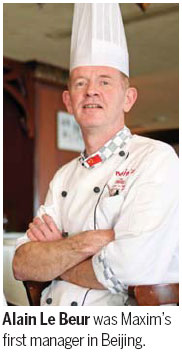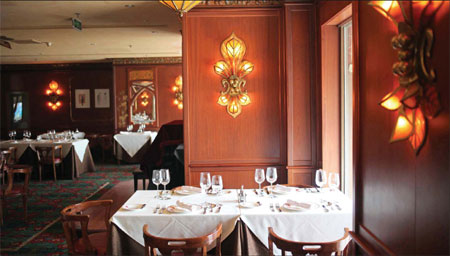Bon appetit, Beijing
Updated: 2013-03-01 09:16
By Todd Balazovic (China Daily)
|
|||||||||||
|
In Maxim's early days, some Chinese saved just for the chance to enjoy a culturally different experience. Wang Jing / China Daily |
When a french chef brought haute cuisine to the capital, just getting his hands on a lemon was a big challenge
For residents of Beijing, the opening of the famously opulent Maxim's restaurant 30 years ago was an early but distinct symbol of changing times and transforming tastes.
When the Parisian restaurant, owned by fashion mogul Pierre Cardin and revered as the acme of high society cuisine, opened in China, it could not have been further from the proletarian championing of preceding decades.
The current chef de cuisine Alain Le Meur's unexpected assignment to Beijing in 1987 meant a giant leap from bourgeois Paris into an environment where fine foreign food was simply unheard of.
 |
"One day Mr Cardin arrived in the restaurant in Paris and told me 'I'm sending you to work for our restaurant in Beijing,'" says the 52-year-old Frenchman with a touch of nostalgia, sitting in the dark wood-trimmed and gilded dining room of the restaurant's newest location in Solana Shopping Center. "It was very sudden."
Then, just 25 years old, Le Meur was given the task of running Maxim's first location at the Chong Wen Men Hotel, at the time one of only two upmarket French venues in the capital, training staff and sourcing hard-to-find luxury cooking ingredients.
"It was difficult for me, because China was not the same as it is today. Back then everything was very different," he says, contrasting Parisian fashion to the large green jackets commonly worn by Beijing people during the 1980s.
"I had so much trouble with the language. I was trying to run a restaurant, but couldn't communicate with the staff. In the end, I would just run around the kitchen making hand gestures to indicate what I wanted done."
Communication aside, the biggest difficulty for the young chef was finding the ingredients essential for fine French cooking.
"At the time, Chinese suppliers didn't understand what was a fine cheese or a good cut of meat, so we had to ship things in from across the world. Most of our ingredients were coming from Australia, France and the US," he says, adding that having a global fashion icon as owner helped greatly when making contacts with suppliers outside China.
But even with the right contacts, moving materials was costly, and testing the quality of products sometimes bordered on farce.
Today's Top News
List of approved GM food clarified
ID checks for express deliveries in Guangdong
Govt to expand elderly care
University asks freshmen to sign suicide disclaimer
Tibet gears up for new climbing season
Media asked to promote Sino-Indian ties
Shots fired at Washington Navy Yard
Minimum growth rate set at 7%
Hot Topics
Lunar probe , China growth forecasts, Emission rules get tougher, China seen through 'colored lens', International board,
Editor's Picks

|

|

|

|

|

|






